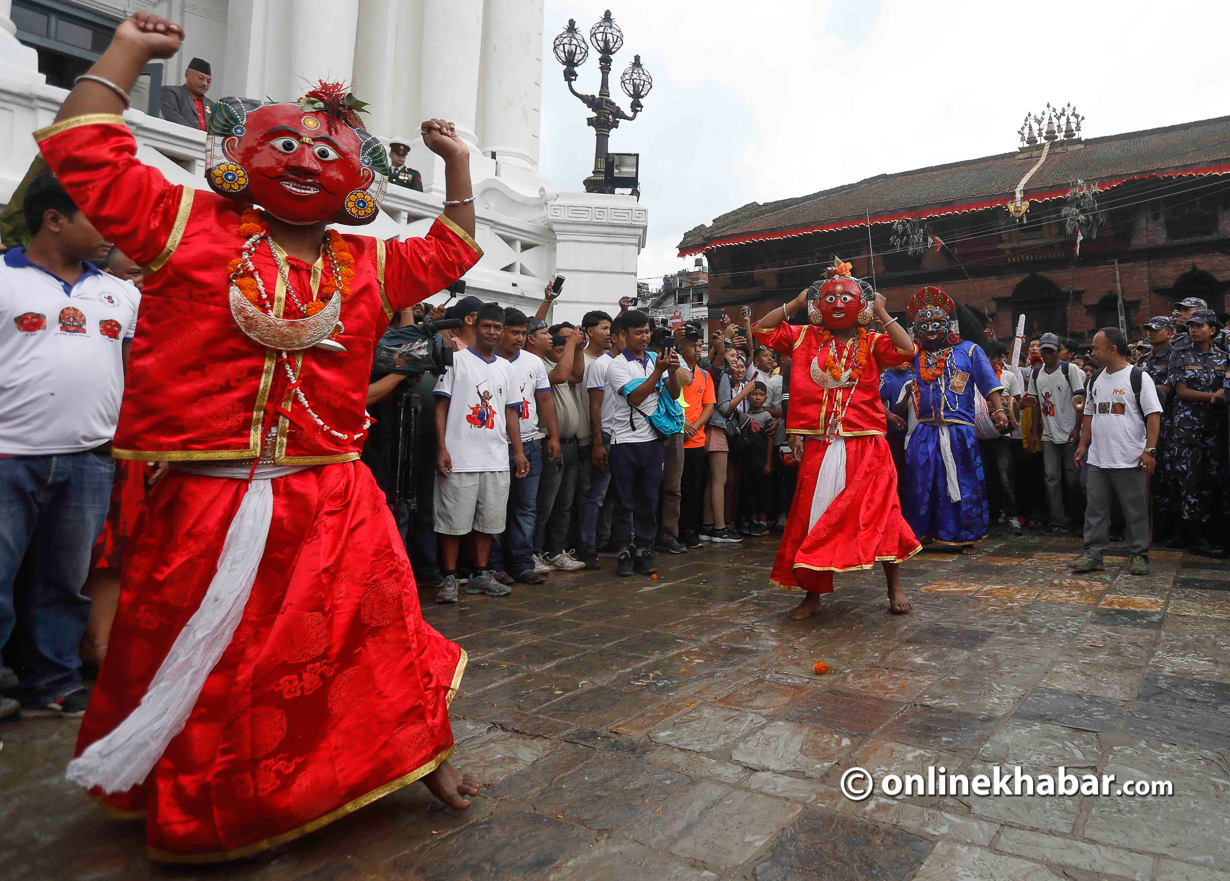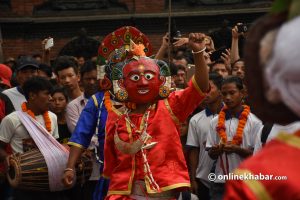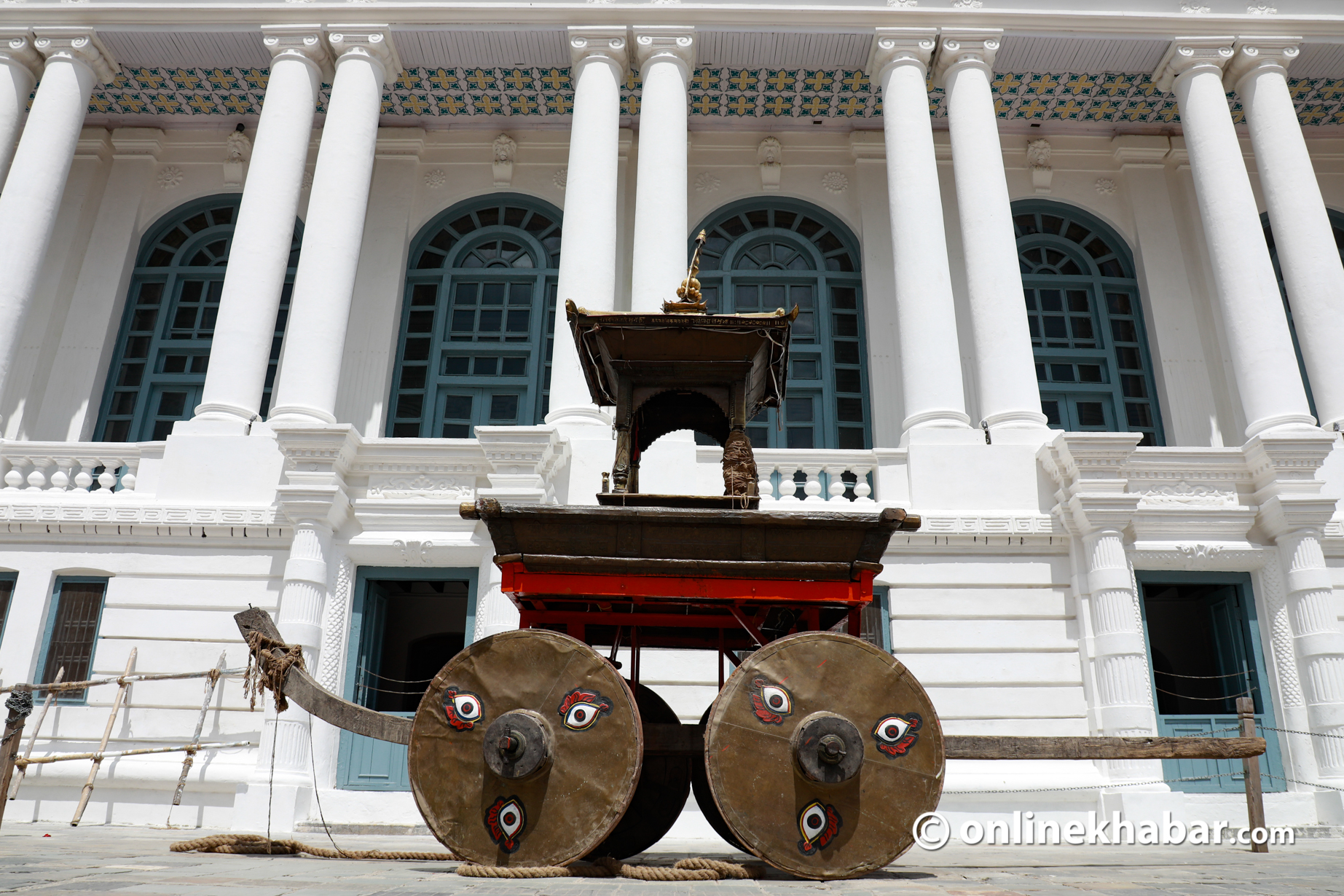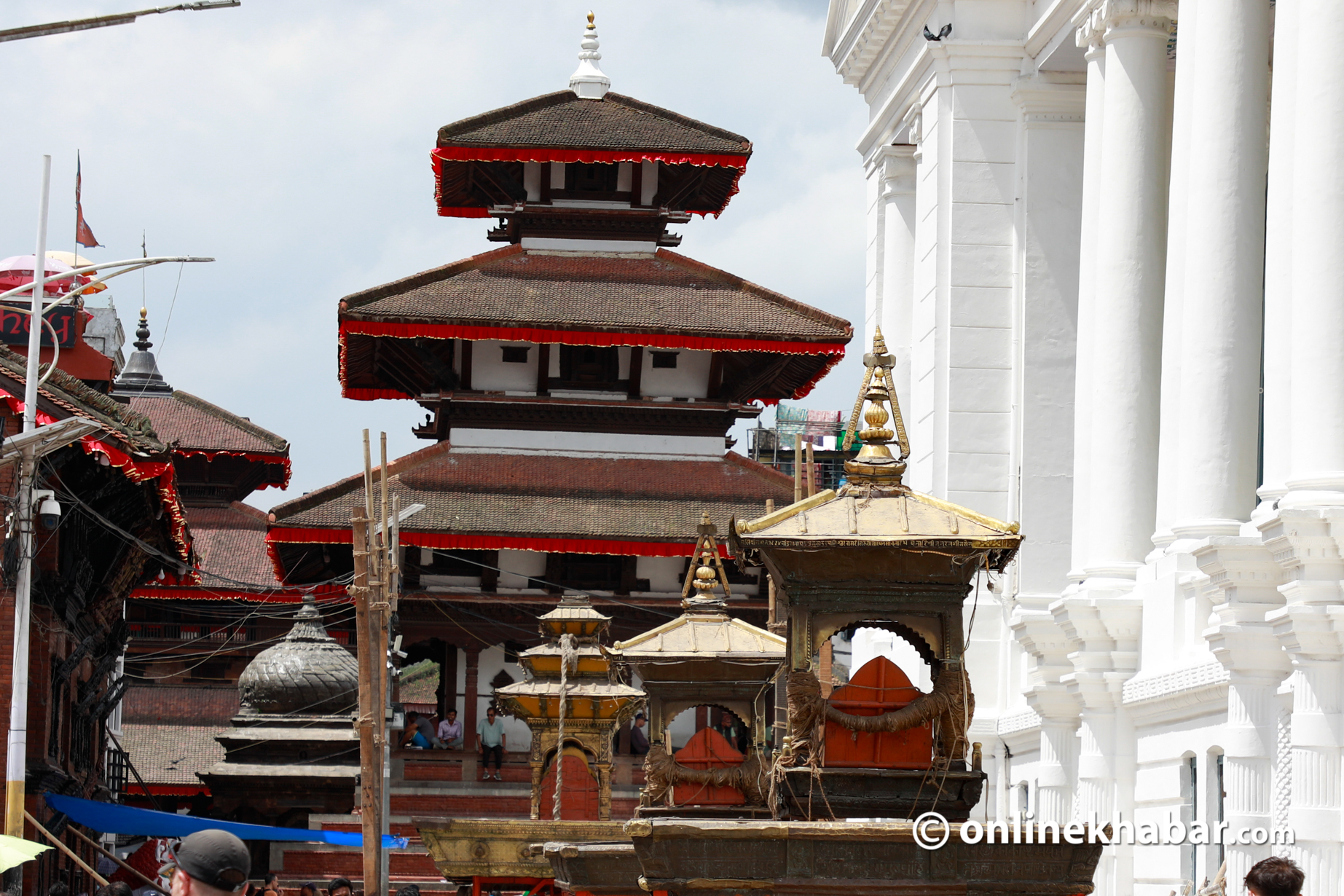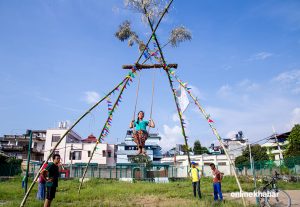Anil Shrestha is counting days for Indra Jatra, a major festival in Kathmandu. The 20-year-old is all excited to see the festival. After a gap of a year, Shrestha is getting his camera ready to click the festival this year. But, going through his photos from yesteryears he realises he has never taken a photo of Aakash Bhairav Naach. And with that, he has also realised he does not know where the three deities involved in this traditional dance event come from or what their story is.
Indra Jatra is one of the most celebrated festivals in the valley. It has so many elements that one has many options to choose their favourites from; Lakhey, Pulukishi, Shwet Bhairav, Dasavatar or the chariot procession itself. But like Shrestha, one easily misses one key and foremost element of the procession; a dance of three masked deities popularly known as ‘jhin tali shin taa’.
As unique as the name it is known for, the story behind it is even more interesting. Even more interesting to know is almost all elements in Indra Jatra have their origins and stories from inside the core city, but this masked trio do not.
So why does the Aakash Bhairav naach has a special place in Indra Jatra?
The story behind
According to popular mythology, there was a plague-like situation in Kathmandu in ancient times. To save the people from the plague, Aakash Bhairav descended from heaven, took shelter in the Halchok hills on the western side of Kathmandu and saved the people. The deity is still worshipped a lot by the locals, even today.
As per the story, children were going missing around the Kathmandu valley. Everyone suspected the roles of Chandi Kumar and Chandi Kumari. The two beings, with big red faces, were mistaken to be demon-like creatures and were accused of harming the children.
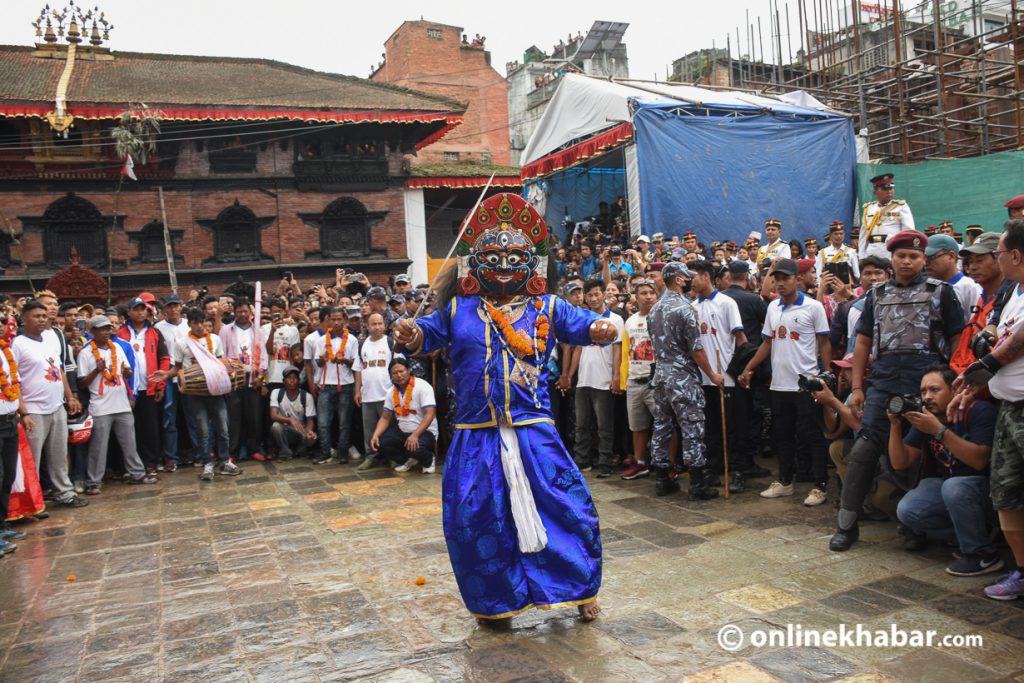
People demanded they be held accountable and presented them in front of Goddess Kumari. Hearing this, Aakash Bhairav, the parent of the two, came in defence and pledged they were innocent. However, people were not ready to let them go and demanded proof of innocence.
So Aakash Bhairav searched for the real culprit. As per the story, there were two culprits. The main culprit is not accounted for properly, but the second one is said to have taken a form of a snake and gone inside a stick. Then, Aakash Bhairav took the proof in front of Kumari and his two children were proven innocent.
As an act of reward or penance for false accusation, Goddess Kumari asked Aakash Bhairav, Chandi Kumar and Chandi Kumari to be present during Kumari Jatra and gave them a special place in the procession, ahead of everyone, even Lord Ganesh, who according to Hindu religion is worshipped and placed first in every ritual. So, following this tradition, one can see the three masked deities today, dancing, in the foremost of the procession, in the tunes of two musical instruments [tah and dhime] flanking them along with a man holding a torch.
The masked dance is commonly but mistakenly called ‘jhin tali shin taa’ (onomatopoeic imitation of the tunes of tah and dhime), but Sagar Putuwar, the naike (head) of Shree Halchok Aakash Bhairavnath Guthi clarifies, “The music is just that the dance is performed to.”
The customs of the naach
The three masked deities–Aakash Bhairav, Chandi Kumar and Chandi Kumari–are a part of 12 deities that reside and perform the naach (dance) in core Kathmandu, during Indra Jatra.
Out of the 12, two–Shingeni and Bhangeni–have already been discontinued from the Aakash Bhairav Naach. “The masks were stolen and even when they were recovered, two were left out. We found the masks years later in Kirtipur, but by then, people had already forgotten the dance and music. So, we performed the kshama puja (a ritual for forgiveness) and put them on hold,” says Putuwar.
The other 10 are continued even today. The 10 masks are taken out yearly, but the whole ensemble only gets to perform as a part of India Jatra every 12 years only. On Bhadra Shuklapaksha Dwadashi, after all the 10 masks are taken out of Dya Chhen (a common house of god) in Halchok, the masks are laid out and they perform a ritual. But, only three are taken out annually to go around Kathmandu city.
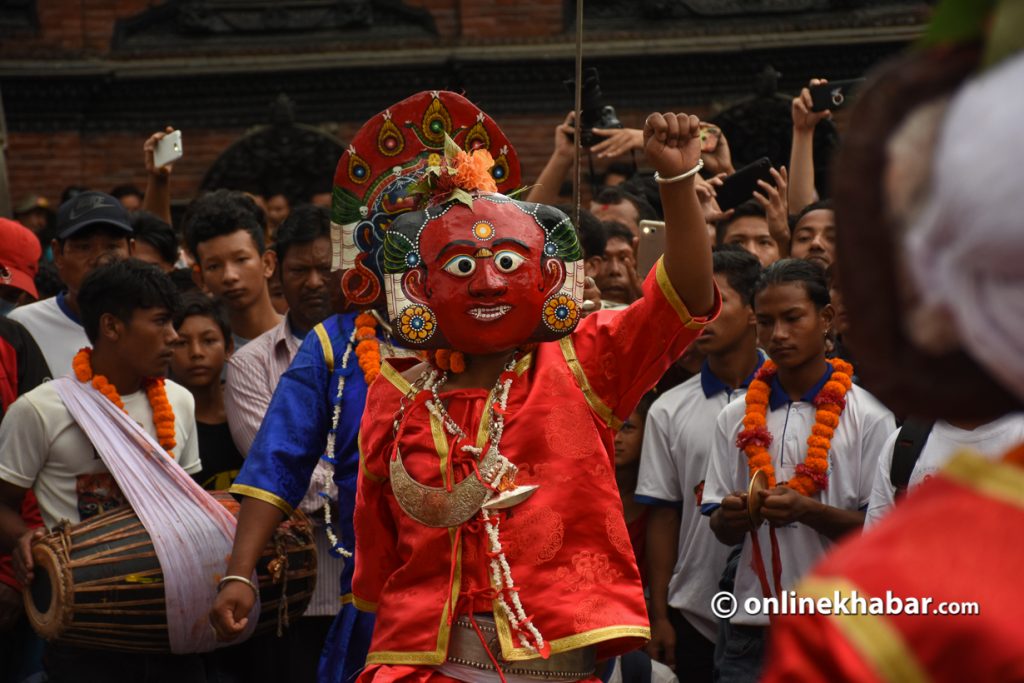
For the annual Aakash Bhairav Naach, on Dwadashi (which is this Saturday), the selected men take a holy bath and, on empty stomachs, perform puja, wear masks and travel on foot to Kilagal. Here, they perform a small ritual and dance at their resting place and also make a round of the city. When the men wearing the masks of the deities, they do not eat or drink much; they only have to eat salt-free food or raw egg and aaila (local alcoholic beverage) as offerings.
For the next five days, the masked deities stay in a room at Kilagal and join living goddess Kumari in her chariot procession around the town, leading the whole procession. On the fifth and last day, Ashwin Krishnapaksha Chaturthi or Nanicha (which is Friday, September 24 this year), they make a last round around the city and then return to Halchok. Here, they perform a concluding ritual and rest for the whole year.
The masks are kept in a box safely, only to be opened next year. On saaparu or Gai Jatra, the masks are briefly taken out and kept in the sun for the day whereas on Bhadra Shukla Pratipada, a day after Kushe Aunshi, the three masks are taken to a Chitrakar family for maintenance and repainting.
For this year, preparations are all done says Putuawar, “All our representatives are fully vaccinated and the Kathmandu Metropolitan City is helping us by providing all safety gears. And the naach will be performed in adherence to the safety protocols.
Every 12 years…
The 12-year naach of the entire 10-member team comprising of Dakshinkali, Mahakali, Barahi, Aakash Devi, Ganga, Mahadev, Parvati, Aakash Bhairav, (Chandi) Kumari and Chandi (Kumar).
It has a few key differences. Unlike the yearly appearances, instead of blue-masked Aakash Bhairav, Aakash Devi, his feminine counterpart, makes an appearance adorning a green mask and is the main attraction of the ensemble. The dance is also taken out in Baisakh (April/May) and not during Indra Jatra.
The men behind the masks have to be from the local Putuwar community and are selected by the gurus of the khalas (local groups). “For the annual festival, anyone who is above 18 years old and is willing to be the masked deity has to learn the dance for a week before the festival. In contrast though, for the 12-year dance, the 10 men chosen have to be virgins and also have to practice the dance for a month,” explains Putuwar.



